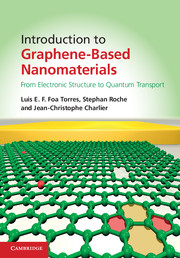Book contents
- Frontmatter
- Contents
- Preface
- 1 Introduction to carbon-based nanostructures
- 2 Electronic properties of carbon-based nanostructures
- 3 Quantum transport: general concepts
- 4 Klein tunneling and ballistic transport in graphene and related materials
- 5 Quantum transport in disordered graphene-based materials
- 6 Quantum transport beyond DC
- 7 Ab initio and multiscale quantum transport in graphene-based materials
- 8 Applications
- Appendix A Electronic structure calculations: the density functional theory (DFT)
- Appendix B Electronic structure calculations: the many-body perturbation theory (MBPT)
- Appendix C Green's functions and ab initio quantum transport in the Landauer–Büttiker formalism
- Appendix D Recursion methods for computing the DOS and wavepacket dynamics
- References
- Index
Appendix A - Electronic structure calculations: the density functional theory (DFT)
Published online by Cambridge University Press: 05 February 2014
- Frontmatter
- Contents
- Preface
- 1 Introduction to carbon-based nanostructures
- 2 Electronic properties of carbon-based nanostructures
- 3 Quantum transport: general concepts
- 4 Klein tunneling and ballistic transport in graphene and related materials
- 5 Quantum transport in disordered graphene-based materials
- 6 Quantum transport beyond DC
- 7 Ab initio and multiscale quantum transport in graphene-based materials
- 8 Applications
- Appendix A Electronic structure calculations: the density functional theory (DFT)
- Appendix B Electronic structure calculations: the many-body perturbation theory (MBPT)
- Appendix C Green's functions and ab initio quantum transport in the Landauer–Büttiker formalism
- Appendix D Recursion methods for computing the DOS and wavepacket dynamics
- References
- Index
Summary
Introduction
Over the last few decades, there has been a significant increase in the use of computational simulation within the scientific community. Through a combination of the phenomenal boost in computational processing power and continuing algorithm development, atomistic scale modeling has become a valuable asset, providing a useful insight into the properties of atoms, molecules, and solids on a scale “often inaccessible” to traditional experimental investigation.
Atomistic simulations can be divided into two main categories, quantum mechanical calculations and classical calculations based on empirical parameters. Quantum mechanical simulations (often referred to as ab initio or first-principles) aims at solving the many-body Schrödinger equation (Schrödinger, 1926). The original reformulation of the Schrödinger equation offered by the DFT provides valuable information on the electronic structure of the system studied.
The very essence of DFT is to deal with noncorrelated single-particle wavefunctions. Many of the chemical and electronic properties of molecules and solids are determined by electrons interacting with each other and with the atomic nuclei. In DFT, the knowledge of the average electron density of the electrons at all points in space is enough to determine the total energy from which other properties of the system can also be deduced. DFT is based on the one-electron theory and shares many similarities with the Hartree–Fock method. DFT is presently the most successful and promising (also the most widely used) approach to computing the electronic structure of matter. In this appendix, the basics of DFT modeling techniques are explained.
Information
- Type
- Chapter
- Information
- Introduction to Graphene-Based NanomaterialsFrom Electronic Structure to Quantum Transport, pp. 314 - 331Publisher: Cambridge University PressPrint publication year: 2014
